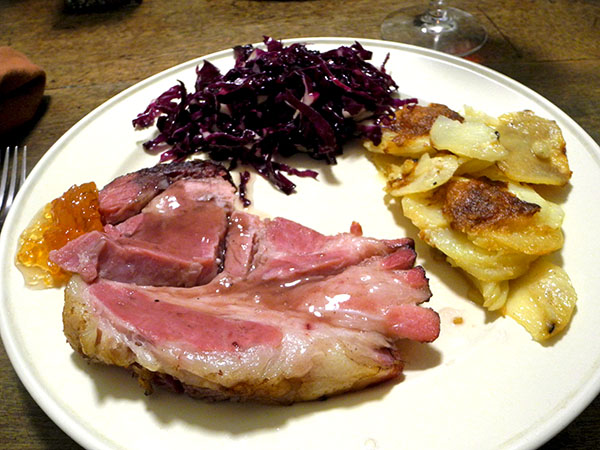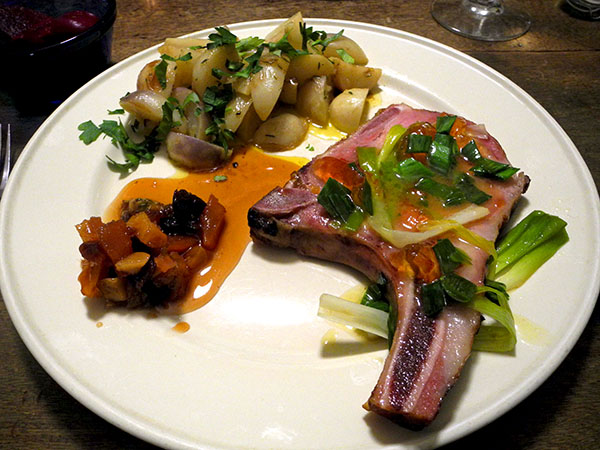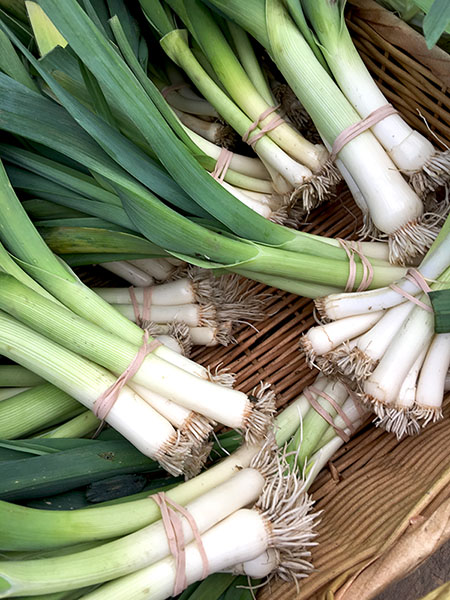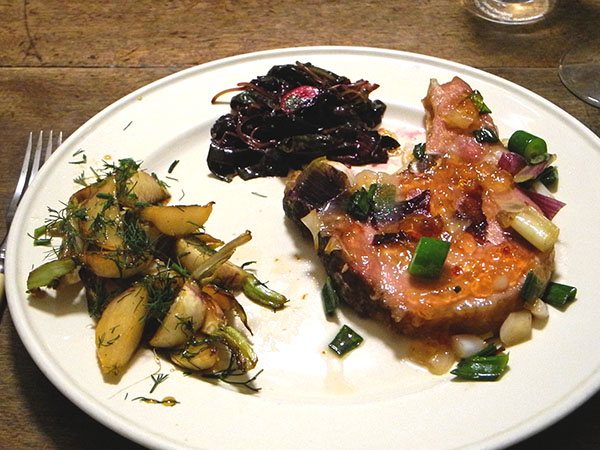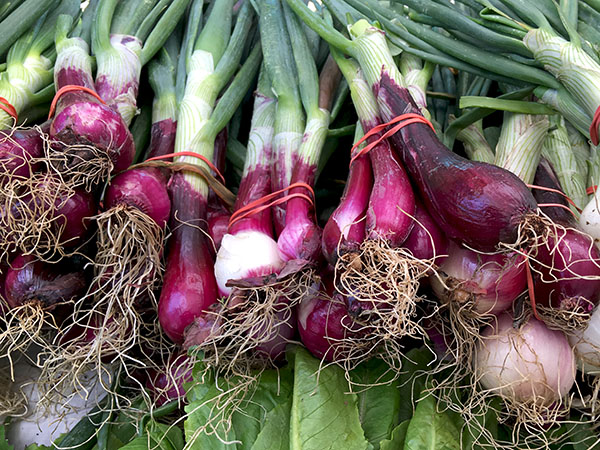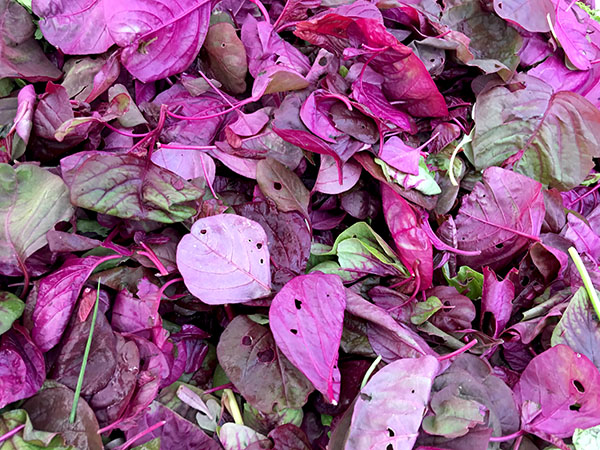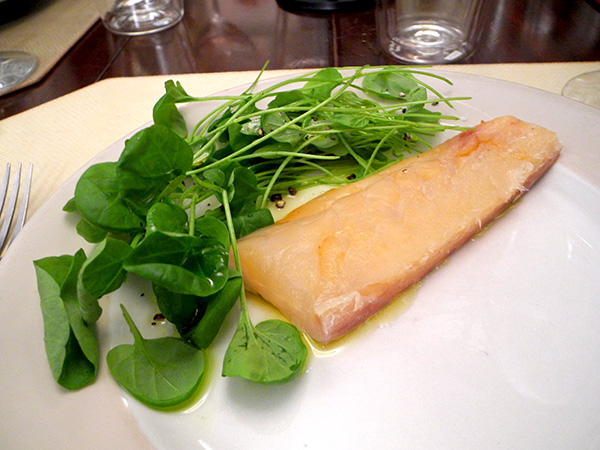
Yesterday I tweeted that our New Years Day dinner would be “Germany with some Italian, and, as always, New York too”. I followed through later in the day, and this post describes what it looked like, as prepared for four.
We began with bread sticks and a sparkling wine, to toast good friends and the new year
I had hoped to serve smoked eel for the first course, but there was none in site in the Greenmarket or anywhere else I look. Instead, I connected with some great smoked halibut from North Atlantic waters.
- smoked haddock from the Lobster Place, with a little dressed upland cress from Two Guys from Woodbridge (a Campania olive oil, Lamparelli O.R.O. from Buon Italia; Maldon salt; freshly-ground black pepper; and a squeeze of juice from a sweet lemon from Fantastic Gardens of Long Island)a
- slices of an Eric Kayser ‘Pain aux Céréales’
- the wine was a German (Franken) white, Weingut Schmitt Kinder Gutswein Silvaner Trocken 2014
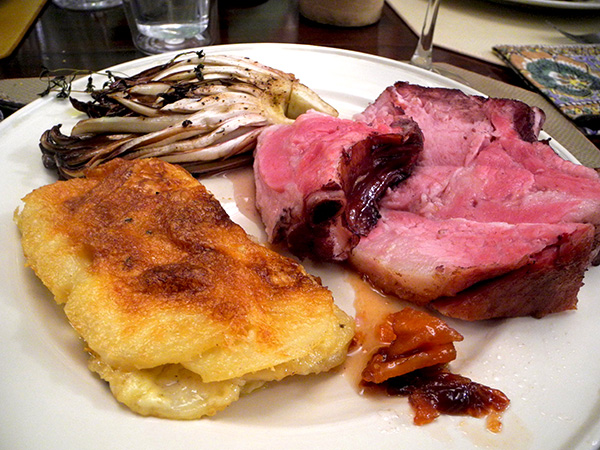
Since there would be 4 of us at dinner, my idea of a smoked pork roast for the main course seemed to make sense for the wow factor, for deliciousness, and for ease of preparation, and that’s what we got.
- one 6-rib 5-pound (more than enough for this meal) smoked pork rack (Kassler), from Pennsylvania, possibly an Amish farm, via O. Ottomanelli and Sons on Bleecker Street in the West Village, trimmed and the fat scored by Joe Ottomanelli (on the side not seen in the image below) rubbed with a mix of salt, pepper, a little of both picante and dulce Spanish paprika, placed in a large enameled cast iron dutch oven with 4 yellow onions and 3 garlic cloves, all diced and all from Lucky Dog Organic Farm, 5 Italian bay leaves from Buon Italia and 8 juniper berries, 6 cups of water and 2 cups of a decent red wine, covered with a lid and cooked in a preheated oven 375° for about 30 minutes, the cover removed and the pork continued cooking for another 25 minutes, basting occasionally, removed from the oven, the meat cut into chops, one rib each, kept warm while some of the cooking liquid was transferred to a smaller saucepan where it was stirred with about 4 tablespoons of water mixed with 2 tablespoons of arrowroot to bind them, served on pre-heated plates with some of the sauce on the top, the remainder poured into a pre-heated sauceboat which was added to the table
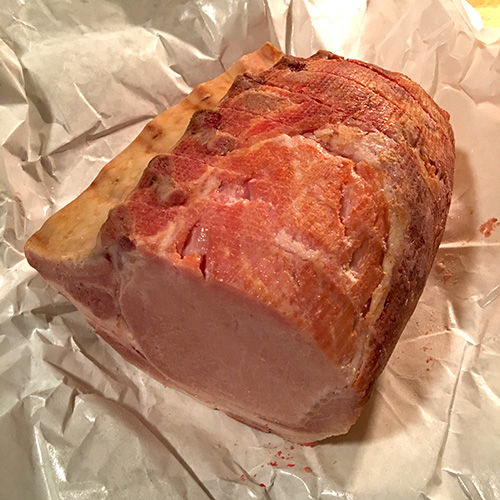
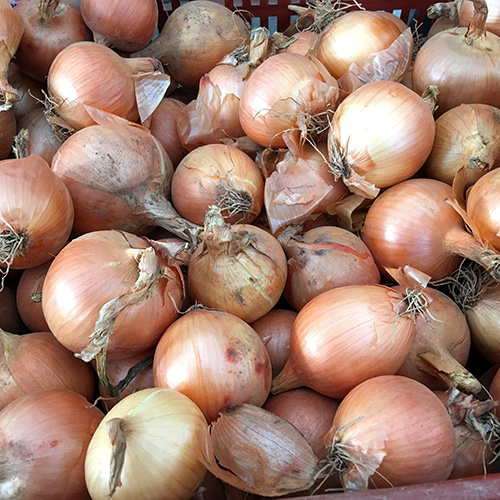
The Kassler was accompanied by Quince chutney remaining from several earlier meals, a potato-horseradish gratin, and roasted tardivo radicchio.
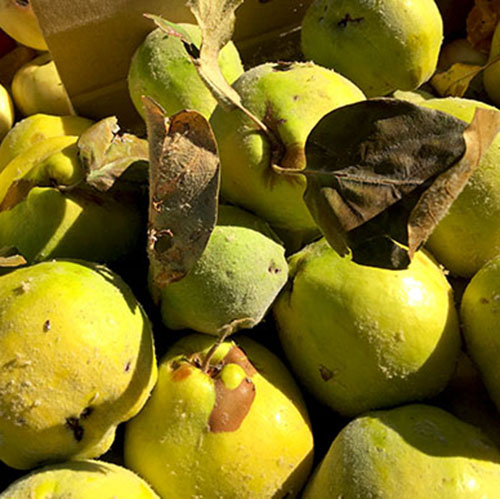


- quince chutney, made following this theKitchn.com recipe, using a shallot from Keith’s Farm, a garlic clove from Stokes Farm, quince from Red Jacket Orchards, dried sweet cherries from Whole Foods, fresh ginger from Lani’s Farm, apple cider from Locust Grove Fruit Farm (the recipe asked for apple cider vinegar, and I do have a bottle of the local stuff, from Race Farm, but I misread the instruction and the dish still turned out more than fine)
- three pounds of russet potatoes from Norwich Meadows Farm, washed, peeled, and thinly-sliced, tossed in a large bowl with 1½ teaspoons salt, ¾ teaspoon pepper, ¼ teaspoon of ground nutmeg, 3 Italian bay leaves from Buon Italia, half of a cup of shaved fresh horseradish from Eataly, and almost 3 cups of Ronnybrook heavy cream, arranged inside a buttered shallow 3-quart enameled cast iron baking dish, pressed to submerge the potatoes completely, covered in aluminum foil and baked in a 400º oven for 25 minutes, the foil removed and the dish continued to bake until the potatoes were tender and the top is golden, about another 50 minutes, removed to rest on the top of the stove until ready to be served [the dish can be prepared ahead of time, allowed to cool, and reheated for 12 minutes]
- two heads of tardivo radicchio, one from Campo Rosso Farm, the other from Italy, via Eataly (Chris and Jessi had only one left when I stopped by their stall in the Greenmarket on Friday, and I really wanted to serve this wonderful vegetable to our guests), prepared pretty much according to this simple recipe, which is to say, washed under cold running water, the moisture shaken off, each head cut in half lengthwise, and a V-cut made inside the root end to allow it to cook more rapidly, the halves arranged inside a ceramic oven pan cut side up, covered with thyme sprigs from Stokes Farm, seasoned generously with salt and pepper, drizzled with2 tablespoons of olive oil, baked for about 12 minutes, turned over, baked for about 8 minutes more, turned so the cut side is up and once again returned to the oven, this time for only a couple minutes or so, or until the stems were tender [the tardivo can be served hot or warm]
- the wines were, first, an Austrian (Burgenland) red, Sankt Laurent ‘Konkret,’ Meinklang – 2009; and then a German (Baden) red, Pinot Noir, Dr. Heger – 2012, both from Astor Wines

There was a cheese course.
- the cheeses were, from left to right in the picture above, Consider Bardwell Farms ‘Manchester’ goat cheese; their ‘Pawlet’ cow cheese; ‘Barden’, a cow blue cheese, also from Consider Bardwell; and ‘Arethusa Blue’, a Connecticut cow blue from Eataly
- thin toasts from the same Eric Kayser ‘Pain aux Céréales’ with which the meal began
- and I brought out a dozen dried Calabrian (Amantea) figs from Buon Italia
- the wine was a California (Napa) white, Matt Iaconis Chardonnay Napa Valley 2015, from Naked Wines
There was a sweet, a very festive sweet!

- struffoli from the Magliulo family’s shop, Buon Italia, made by Tonia, who, with her husband Mimmo, owns this wonderful place
- the music throughout was the conversation of four friends and one very smart baby
[the image of the struffoli is from the archive, although the sweet was made by the same woman; the one I took last night turned out a little blurry after several courses with wine]
